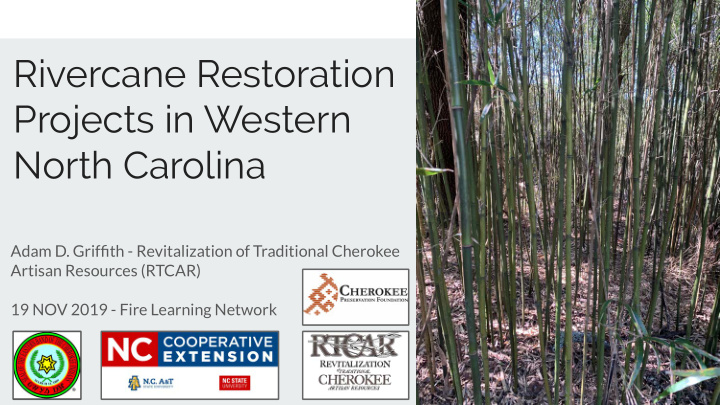



Rivercane Restoration Projects in Western North Carolina Adam D. Griffith - Revitalization of Traditional Cherokee Artisan Resources (RTCAR) 19 NOV 2019 - Fire Learning Network
Restoration: from what? Before European contact? After Native American removal? 2
Restoration: from what? Before European contact? After Native American removal? To what? Monoculture? Multispecies riparian buffer? 3
Restoration: from what to what? 4
Restoration: from what to what? YES! 5
Restoration: from what to what? YES! Plant ubiquitous in southeast 6
Why is restoration necessary? - Cultural significance - 2% of original habitat remains (Noss, 1995) - probably less - Population growth - Development pressure - Demand for plant: DOT, NFPs, EBCI, private land owners 7
Restoration methods: - Plant from seed - Nursery material - Transplant 8
Restoration methods: - Plant from seed - Nursery material - Transplant 9
Cherokee Restoration Efforts - Cherokee Central Schools - Photo below from 2007 - Fall 2008 and Spring 2009 10
Cherokee Restoration Efforts - Cherokee Central Schools - Photo below from 2007 - Fall 2008 and Spring 2009 11
Cherokee Restoration Efforts - Cherokee Central Schools - Photo below from 2007 - Fall 2008 and Spring 2009 12
Cherokee Central Schools - Multiple donor sites (5+) - Both hand dug clumps and bare root plants - Did not trim tops of plants - short travel distance 13
Cherokee Central Schools 14
Cherokee Central Schools - Clump survival close to 100% - Bare root survival low 15
Warren Wilson College - Removing ½ acre of river cane for restoration - Conscientious project manager emailed us - Cane being moved via seven different project partners: City of Asheville, City of Hendersonville, Nature Conservancy, Conserving Carolina, Veterans Healing Farms, EBCI Schools 16
Warren Wilson College - Remnant patch - Confined for decades by mowing, agriculture - Culm diameters under 1/2 “ 17
Genetics - Concern over introduction of different population - Artificial transportation 18
19
Timing - Originally planned for September - Then October - Then this month - Now January 2020 20
Methods - Trim plants to ~4 ft. - Remove top ~12 inches of soil using a 3 ft. bucket on a track-hoe - Cover with tarps for transport on flatbed trailers - Unloaded the same day (ideally) 21
Opportunities - Will learn about nurture vs nature regarding culm diameters - Will learn about transplanting methods - Will learn about logistics 22
Is river cane the perfect riparian buffer species? In this area, yes! adgriff5@ncsu.edu 23
Is river cane the perfect riparian buffer species? In this area, yes! Questions? adgriff5@ncsu.edu 24
Is river cane the perfect riparian buffer species? In this area, yes! Questions? adgriff5@ncsu.edu rtcar2004@gmail.com 25
Recommend
More recommend